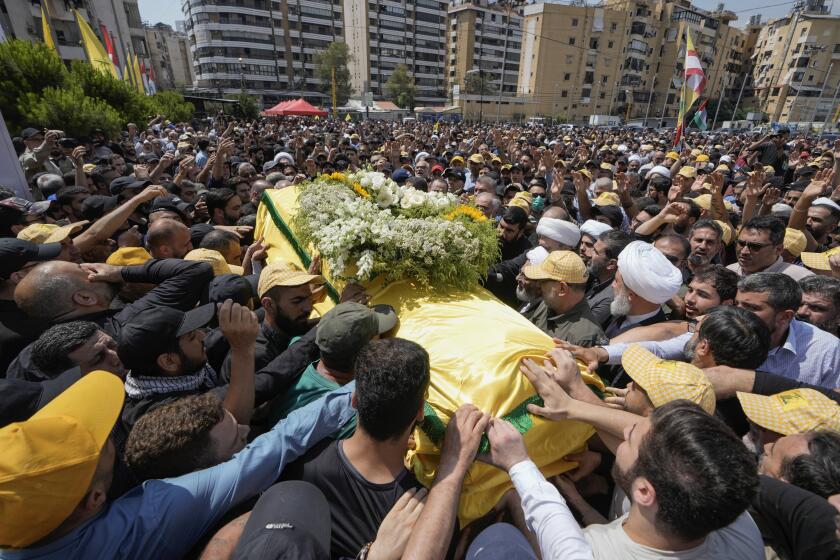Gut Instinct Gets Scientific on Border
There’s no lying to Eugenio Garza Jr., though people often try. Sometimes he sniffs out trouble before people even utter a word.
Garza, the U.S. Customs and Border Protection port director here, has spent more than a quarter-century on the boundary between the United States and Mexico, honing instincts that allow him to sort the day-trippers from the deceitful with little more than a glance. Not too long ago, he dropped in on a border inspection post to brief an officer, happened to look down at the driver of a waiting Grand Marquis and instantly ordered a search; it turned up 100 pounds of marijuana in the gas tank and side panels.
“You have about 22 seconds to figure out whether someone is fully telling the truth,” said Garza, an athletic 54-year-old with spit-and-polish black boots and impeccably pressed khakis. “A good agent can just sense when something is not right.”
That intuition takes years to develop, but today there isn’t time to do things the old-fashioned way. The threat of terrorism has added new urgency to U.S. border monitoring. The agency has fortified ports of entry with sophisticated computer systems, and it is wooing hundreds of new recruits.
Now, in a secure federal facility in Georgia, Customs and Border Protection is coaching its agents to use the ancient weapon Garza employs every day: gut instinct.
The three-day class, “Deception Detection and Eliciting Responses,” draws on behavioral science to refine agents’ interviewing technique and sharpen their ability to pick up on a lie. Agency officials are tight-lipped about the course, but outside experts describe a field of science focused on the unintended signals people often send when they lie.
“The people on our front line for terrorism are probably city police and immigration and customs people,” said Paul Ekman, a retired psychology professor at UC San Francisco. “The only way to make [detecting deception] practical is to train people, without computers, without measurements, just get them to use their eyes and ears.
“It’s not a panacea, but it’s another tool in the toolbox.”
Changes in breathing, the rising pitch of a voice, the way someone moves -- or doesn’t -- can all signal the stress of trying to hide something.
For example, people who are telling lies often unconsciously lean back, away from the person they’re lying to.
Subjects who want to fend off questions may try to build barriers between themselves and the questioner by unconsciously moving bags, magazines, hats or other objects in front of them.
And, surprisingly often, a person falsely denying something will unwittingly nod his head up and down, in an unspoken acknowledgment of the truth.
Systematic research into verbal and nonverbal clues to deception began in the late 1960s. Scientists herded college students into labs to examine the physiological chain reactions that start when people fib. Film documented the minute details of face and body movements.
And in the 1990s, scientists began to examine the neurological dimensions of deception, peering into living brains to find which areas grow more active during a lie.
Now, after almost four years of post-Sept. 11 emphasis on complex legal and technological strategies for preventing terrorist attacks, almost every major federal security agency is exploring new developments in deception detection, looking for ways to capitalize on skills that are second nature to seasoned beat cops.
The Department of Defense is pouring millions into research, including one project that examines whether it’s possible to detect deception in e-mail.
“9/11 absolutely has driven new interest in getting it right on deception detection for the defense, intelligence and law enforcement communities,” said Scott Gerwehr, an expert in deception at the Rand Corp. in Santa Monica.
There are skeptics and there are challenges, particularly when it comes to “reading” someone from a different culture, but agencies that use behavioral science techniques report success, and those learning about them are enthusiastic.
Customs and Border Protection started training its front-line officers in February. The classes, developed in-house, emphasize counterterrorism and cross-cultural communication.
Eventually, 30,000 personnel will be trained.
“Already people are phoning and telling us how effective they think it will be,” said Thomas J. Walters, the agency’s assistant commissioner for training and development.
High over the muddy green Rio Grande, a blackened brass plaque on the Lincoln-Juarez Bridge marks the point where Mexico ends and the United States begins. About 100 feet into U.S. territory, the U.S. Customs and Border Protection gateway curves across the road.
Vehicles in the 12 entry lanes must pass through highly sensitive radiation-detection portals. For commercial truck drivers who cross the border frequently and have been screened by the U.S. government, biometric devices match face to fingerprint to name in seconds. U.S. agents and their drug-sniffing dogs thread through the waiting cars under a sky poached pale by the 100-degree heat.
And at the gate, Border Patrol officers and Customs agents wait to conduct the personal interview. Eighteen thousand cars drive through this port of entry every day.
“We can’t use the technology on everybody; otherwise, we would have lines down to Mexico,” said Ramon Juarez, the assistant port director.
The port’s chief officer, Jesus Saldivar, said, “It’s the human nature element that’s key.”
Saldivar, Juarez and port director Garza have worked together since the 1970s and like to say they have a collective 80 years of experience. It shows. They have an easy rapport and a trove of stories about their inner alarm bells leading to arrests.
But ask them to explain what tips them off and they can’t really do it.
They “just saw something,” or it was “just the way someone responded.”
The process of introducing behavioral science into the training of law enforcement officers starts with the fact that researchers have identified four basic ways people signal discomfort. These signals don’t necessarily indicate a lie in progress, but they do tell an observer that people are not comfortable and may be hiding their true feelings.
First, the nervous system kicks in -- the heart rate quickens, hair rises, sweat glands start pumping, breathing speeds up, skin flushes or blanches.
The way people speak may change, with words tumbling out more quickly or the pitch of the voice climbing. They may pause, clutter their speech with “ums” and “uhs,” or verbally distance themselves from the subject being discussed -- saying, for instance, that “the glass was broken,” not “I broke the glass.”
Verbal content is another signal of discomfort. Stories that are too neat and linear raise a red flag. Truthful answers tend to be unstructured, jump backward and forward in time, and often include an element of self-doubt: “John put the glass too close to the counter’s edge -- at least, I think it was John.”
And then there’s the body, which experts say leaks information like a sieve. People blink more often when they are emotionally stressed, and their pupils dilate -- though it’s impossible to be sure whether people are angry, excited or scared. Micro-expressions, a split-second flash of concealed emotion, can be a more accurate guide, and one that works across cultures.
Ekman, who has been studying facial expression for 51 years and deception since 1967, has coached more than 5,000 law-enforcement officers, some of whom write him about their successes.
One Foreign Service officer based in Amsterdam wrote that she saw a flash of disgust cross a visa applicant’s face in response to an innocuous question. Surprised, she investigated further. The applicant was using a false identity and was wanted in the United States.
He now awaits extradition.
More to Read
Sign up for Essential California
The most important California stories and recommendations in your inbox every morning.
You may occasionally receive promotional content from the Los Angeles Times.










